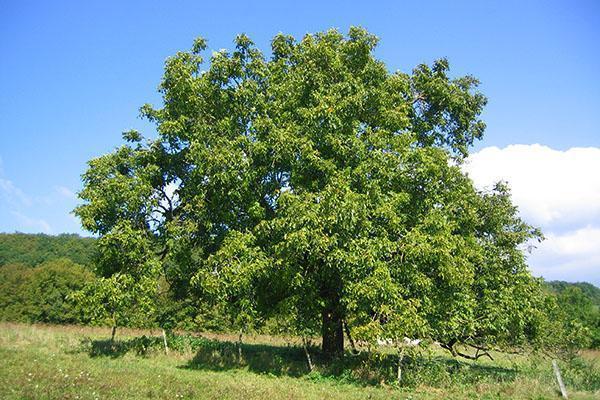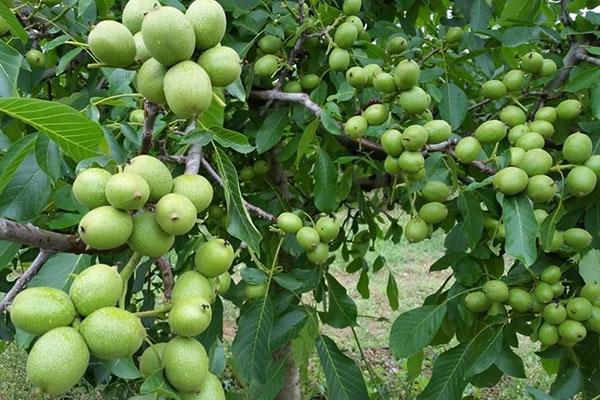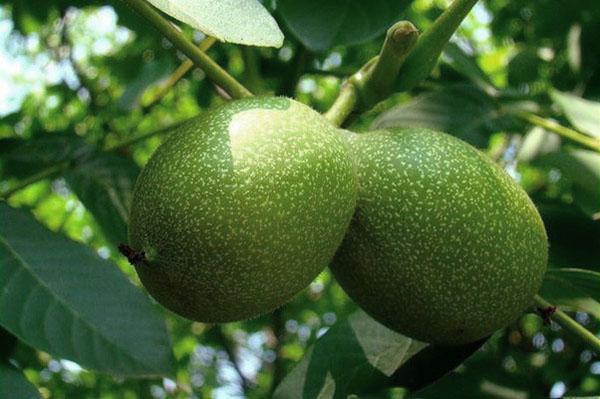Photos with descriptions of walnut varieties
 Walnut - a valuable crop, massively grown in Central Asia and Ukraine, in the south of Russia, in Moldova and on the territory of Belarus. Back in the days of the USSR, numerous varieties of walnuts with high yields, excellent frost resistance and non-capricious disposition were obtained and have proven themselves well. Today, breeders from different countries continue this work, so the range of varieties that are interesting for gardeners has expanded significantly.
Walnut - a valuable crop, massively grown in Central Asia and Ukraine, in the south of Russia, in Moldova and on the territory of Belarus. Back in the days of the USSR, numerous varieties of walnuts with high yields, excellent frost resistance and non-capricious disposition were obtained and have proven themselves well. Today, breeders from different countries continue this work, so the range of varieties that are interesting for gardeners has expanded significantly.
Walnut Ideal, photo and description

Walnut Ideal tolerates frosts up to 30–35 ° C. Winter is well tolerated not only by the bark and perennial wood, but also by the shoots of the last year.
If a cold snap can damage this variety, then in the spring, during return frosts. In this case, the situation is saved by prolonged repeated flowering, which compensates for the loss of flower buds that opened in May.
Combined in a brush, smooth oval nuts weighing 10-12 grams are harvested from mid-September. The large kernel accounts for more than half the weight. The shell of this type of walnut is thin, easily separated from the kernel.
Walnut Giant
 Another popular variety among Russian gardeners is the Giant walnut, named for its truly large fruits, which can weigh up to 35 grams. In terms of yield, this crop is close to the previous variety. The trees are also quite compact, and their spreading crown does not exceed 5-7 meters in height.
Another popular variety among Russian gardeners is the Giant walnut, named for its truly large fruits, which can weigh up to 35 grams. In terms of yield, this crop is close to the previous variety. The trees are also quite compact, and their spreading crown does not exceed 5-7 meters in height.
The Giant variety is resistant to common diseases of the walnut, is not afraid of the harsh Russian winters and bears excellent fruit with moderate moisture and soil nutritional value.
Walnut variety Graceful
 To get a harvest of nuts for gardeners of the middle lane is hampered by the long growing season of the plant and its fear of cold weather.
To get a harvest of nuts for gardeners of the middle lane is hampered by the long growing season of the plant and its fear of cold weather.
Thanks to the work of breeders, varieties have appeared that solve both these problems. These early ripe, unpretentious varieties include the Graceful walnut, whose fruits of excellent quality and sweetish taste are ready for harvest in mid-September. Moreover, the trees:
- are not afraid of drought and common diseases;
- rarely affected by pests;
- well leafy crown up to 5 meters high is easily maintained in a private garden.
However, with a high yield, reaching 20 kg per tree, the plants do not survive frost well, during which the buds are affected, skeletal branches and trunk suffer.
Walnut Harvest
 Trees of this variety grow up to 6 meters in height, are unpretentious to growing conditions and winter well even in harsh conditions. The Harvest walnut got its name due to its excellent fertility. Already from the fourth year of life, plants are capable of producing 10 kg of selected nuts weighing more than 10 grams. Their collection begins in mid-September and, depending on the region of planting, ends towards the end of October.
Trees of this variety grow up to 6 meters in height, are unpretentious to growing conditions and winter well even in harsh conditions. The Harvest walnut got its name due to its excellent fertility. Already from the fourth year of life, plants are capable of producing 10 kg of selected nuts weighing more than 10 grams. Their collection begins in mid-September and, depending on the region of planting, ends towards the end of October.
Walnut variety Aurora
 Among the early-ripening varieties resistant to frost and diseases, the Aurora walnut enjoys increased attention of gardeners.Unlike Ideal or Giant, these trees are much more powerful and taller. The first ovaries appear on plants at the age of four, and as they mature, plantings give larger and better yields. On average, the mass of a nut reaches 12 grams, the kernel with a good table taste makes up more than 50% of the mass.
Among the early-ripening varieties resistant to frost and diseases, the Aurora walnut enjoys increased attention of gardeners.Unlike Ideal or Giant, these trees are much more powerful and taller. The first ovaries appear on plants at the age of four, and as they mature, plantings give larger and better yields. On average, the mass of a nut reaches 12 grams, the kernel with a good table taste makes up more than 50% of the mass.
Walnut variety Zarya Vostoka
 Another undersized walnut quickly entering the fruiting season forms a crown 3-4 meters high. Although nuts of the Zarya Vostoka variety cannot be called large, their weight is 9-10 grams, the culture pleases with yields of up to 25 kg per tree.
Another undersized walnut quickly entering the fruiting season forms a crown 3-4 meters high. Although nuts of the Zarya Vostoka variety cannot be called large, their weight is 9-10 grams, the culture pleases with yields of up to 25 kg per tree.
Walnut Breeder
 A little less, about 20 kg of walnuts, is provided by the Breeder. The culture oriented to the southern regions is characterized by stable, annual fruiting with a predominantly crown arrangement of ovaries. Despite the resistance to diseases and pests, the plants do not tolerate frost well. After a harsh winter, not only the buds suffer, but also the perennial wood, the bark of skeletal branches and the trunk.
A little less, about 20 kg of walnuts, is provided by the Breeder. The culture oriented to the southern regions is characterized by stable, annual fruiting with a predominantly crown arrangement of ovaries. Despite the resistance to diseases and pests, the plants do not tolerate frost well. After a harsh winter, not only the buds suffer, but also the perennial wood, the bark of skeletal branches and the trunk.
Tall varieties of walnuts for pollination, grafting and gardening

Since most walnut varieties are fully or partially self-sterile, they need pollinators.
As such plants, breeders offer varieties:
- Spectrum with up to 14 meters high winter-hardy trees and heavily ribbed large nuts;
- Orion, also reaching 16 meters in height and producing 11 gram egg-shaped nuts with light shells;
- Marion, just as tall and powerful, yields 12g thick-shelled nuts.
These walnut varieties are often used not only as pollinators, but also as strong rootstock, and also, thanks to the powerful, excellent leafy crown, for landscaping.
Ukrainian and Belarusian walnut varieties
 In the south of Russia and in Ukraine, Ukrainian varieties are cultivated. These varieties include:
In the south of Russia and in Ukraine, Ukrainian varieties are cultivated. These varieties include:
- Bukovinsky 1 and 2;
- Bukovina Bomb;
- Carpathian;
- Transnistrian and more than a dozen interesting fruitful varieties with medium or large nuts.
Recently, scientists of Belarus have been closely involved in the selection of walnuts. The most famous of their varieties is the Memory of Minova walnut.
 This variety, which underwent variety trials 15 years ago, belongs to large-fruited. The ovary forms on powerful large trees annually, mainly on the tops of the shoots. For the first time, fruiting from this variety should be expected 6 years after planting. Harvesting takes place in the second half of September.
This variety, which underwent variety trials 15 years ago, belongs to large-fruited. The ovary forms on powerful large trees annually, mainly on the tops of the shoots. For the first time, fruiting from this variety should be expected 6 years after planting. Harvesting takes place in the second half of September.
The further south the walnut is grown, the taller varieties are used by gardeners. For example, in Moldovan gardens, trees are not rare, reaching a height of 20-25 meters. But even these local plants are far from the powerful black walnut native to North America, which grows up to 40 meters in height.
 This culture is more and more interesting for gardeners who know about the beneficial properties of the fruits of this tree and the decorative qualities of its wood. Despite the similarity in appearance, walnut and black walnut are two different species with different characteristics and agricultural techniques.
This culture is more and more interesting for gardeners who know about the beneficial properties of the fruits of this tree and the decorative qualities of its wood. Despite the similarity in appearance, walnut and black walnut are two different species with different characteristics and agricultural techniques.
where you can buy walnut seedlings. I wrote out the Manchurian variety, but it did not go with me.
For growing on your site, it is best to plant zoned varieties. You can buy such varieties in the markets or in garden centers, having previously found out which variety bears fruit well in your region. The variety you like according to the description is not always suitable for your climatic conditions.
Please tell me what sort of walnut can reach a height of 25-30 meters, oval-shaped fruits with a very thin shell? In one inflorescence up to 9 nuts bore fruit ... Due to the fact that the tree was shading the whole garden, it was piled.And now the variety is lost, it was brought from Siberia in the 80s ... Thanks in advance for your help.
Almost all walnut varieties of Moldovan, Ukrainian and Belarusian selection can grow up to 30 meters if their growth is not stopped by special pruning. The further south the nuts grow, the thinner their peel is. Many varieties have oval fruits. To determine the variety, you need to see the fruit of the tree. Sorry, I can't help you.
Can you please tell me if it is possible to book a nut that is too tall? Will he get sick? It shades half of the garden, but I don't want to cut it down, I would like to reduce it by half. Grew up to about 15 meters.
This operation is best done in the fall. Treat the cut site with a clay mash or garden pitch.